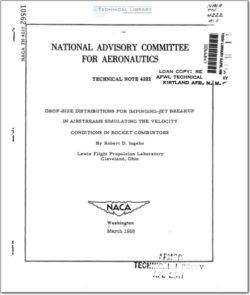NACA-TN-4222

- Version
- 179 Downloads
- 669.47 KB File Size
- 1 File Count
- December 4, 2015 Create Date
- December 4, 2015 Last Updated
National Advisory Committee for Aeronautics, Technical Notes - Drop Size Distributions for Impinging Jet Breakup in Airstreams Simulating the Velocity Conditions in Rocket Combustors

The specific impulse obtained for a given fuel and oxidant combination
is a function of the completeness of burning in the rocket combustor. In
the case of a hydrocarbon - liquid oxygen propellant combination, the
relatively low vaporization rate of the hydrocarbon may limit the complete—
ness of burning and hence the performance of the engine. In reference 1,
vaporization-rate equations based on assumed drop—size distributions for
hydrocarbon sprays are integrated with the aid of digital computers, and
rocket engine performance is related to atomization and vaporization.
However, quantitative performance values could not be predicted from the
results, primarily because of lack of knowledge of the drop-siZe distri-
butions produced by rocket injectors. If drop-size distributions were
known, vaporization-rate equations could be applied more rigorously to
predicting rocket engine performance. Accordingly, the purpose of this
study was to Obtain drop-size-distribution data for a rocket injector ”
similar to that used in reference 1. A nonburning airstream environment
of relatively low temperature and pressure was used to simulate rocket-
combustor velocity conditions.
Sevsral investigators have photographed sprays produced by pairs of
impinging jets (ref. 2) to obtain spray-pattern photographs. However,
their methods did not yield drop-size-distribution data. Dr. Tanasawa
(ref. 5) has studied "flat impingement" (180° impingement of opposing
jets) in "still air" and has obtained drop-size-distribution data. In
the present study pairs of 90° impinging jets were used.
Dropssize—distribution data previously have been obtained for cross—
current breakup of liquid jets in airstreams by means of a high-speed
camera (refs. 4 and 5). The same camera equipment was used in the present
investigation to study the breakup of impinging nfheptane jets in airstreams
simulating rocket—combustor velocity conditions. Accordingly, drop—size-
distribution data were obtained for ranges of injector-orifice diameter,
liquid-jet velocity, and velocity difference between the airstream and
the liquid jets. Finally, an empirical drop-size-distribution expression
was derived from an analysis of the data.
| File | Action |
|---|---|
| naca-tn-4222.pdf | Download |

Comment On This Post